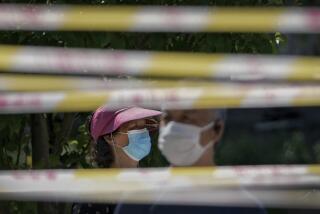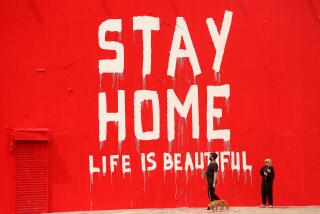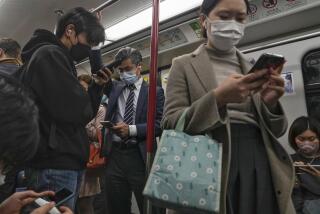Hong Kong Removed From List of SARS-Affected Areas
- Share via
HONG KONG — Amid public celebration, smiles and some cautionary words about the future, residents of Hong Kong on Monday marked the official removal of their territory from the World Health Organization’s list of SARS-affected areas.
The step is in many ways a milestone in global efforts to contain one of the world’s newest infectious diseases. Of the 8,459 people known to have been infected with SARS worldwide, more than 1,700 were in Hong Kong. Only mainland China has reported more cases.
In the wake of the WHO statement, only Beijing, Toronto and Taiwan remain on the organization’s list as seriously affected by SARS.
Though some medical scientists believe the virus could return in the winter, Monday’s development brought relief across the region.
“We love Hong Kong!” shouted a Brazilian dancer as onlookers applauded at a government-sponsored street party near the Kowloon Ferry terminal. Across the harbor, in the restaurant and bar district of Lan Kwai Fong, customers toasted the event with champagne, while at schools throughout the territory, smiling youngsters ripped off the protective masks they had been forced to wear in class.
At a news conference, the Hong Kong Tourist Board unveiled plans for a $50-million television ad campaign to lure back visitors, part of a larger effort to revive the economy.
David Heymann, the WHO’s executive director of communicable diseases, praised Hong Kong’s efforts to contain SARS as a “very significant achievement.”
“Hong Kong, with its dense population and fluid border with China, had one of the hardest outbreaks to control,” he said in a statement posted on the WHO Web site.
Speaking at the Amoy Gardens public housing project where SARS struck hundreds of residents in March, Hong Kong Chief Executive Tung Chee-hwa greeted onlookers and reporters with a thumbs-up sign, but warned against complacency.
“From experiences everywhere else, we have to remind ourselves that this could come again,” he said. “We have to learn from our experience so we’re better prepared if it does come again.”
The pneumonia-like coronavirus known as severe acute respiratory syndrome, which apparently migrated from animals to humans last fall in southern China, has killed 805 people worldwide, 296 of them in Hong Kong. SARS has devastated Hong Kong’s economy, whose lifeblood is international business, trade and tourism. Because authorities on mainland China initially attempted to cover up its SARS cases, the Hong Kong outbreak was the first to generate global awareness of the disease.
A series of travel warnings from the WHO and from national governments, including the United States, slowed the flow of visitors to Hong Kong a trickle.
At the height of the territory’s outbreak this year, restaurants would open and close without a single guest, occupancy at the most prestigious hotels hovered around 5% to 10%, and the region’s leading airline, Cathay Pacific, canceled two-thirds of its flights.
The travel warnings have largely been lifted, and both government and business leaders in the region expressed hope that Monday’s announcement would end the territory’s status as a de facto international outcast.
With a countdown usually reserved for New Year’s Eve, nervous civil servants waited for the WHO to post the announcement on its Web site. The notice certified that Hong Kong had gone 20 straight days without a new case of SARS being discovered and was thus eligible for removal from the list.
Twenty days constitutes twice the incubation period of the disease.
More to Read
Sign up for Essential California
The most important California stories and recommendations in your inbox every morning.
You may occasionally receive promotional content from the Los Angeles Times.













